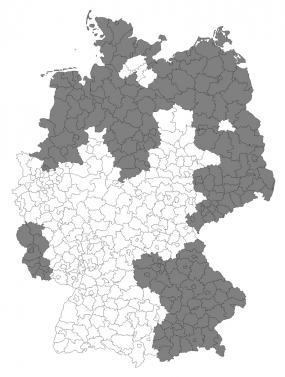Cancer survival depends on where people live
Based on an analysis of data from one million cancer patients, scientists from the German Cancer Research Center (Deutsches Krebsforschungszentrum, DKFZ) have discovered for the first time that cancer survival depends on the socioeconomic conditions of the place where people live. The DKFZ is making the announcement on the occasion of World Cancer Day on February 4. Patients from economically weak districts have poorer chances of survival, particularly during the first three months after a diagnosis.
Cancer researchers know that globally, cancer patients have better chances of survival if they are wealthy than if they are poor. But does this also hold true in Germany, which counts among the richest countries in the world and where practically everyone has health insurance? At the German Cancer Research Center (DKFZ), a team of scientists led by Professor Hermann Brenner have now studied this question in detail for the first time.
The researchers analyzed data from ten of the 16 state cancer registries in Germany, which combined cover almost 40% of the total population*. The recent analysis includes one million patients who were affected by one of the 25 most common types of cancer between 1997 and 2006.
To protect patient anonymity, the analysis was based on districts ("Landkreis") rather than places of residence. The epidemiologists classified the districts according to a set of paramaters describing their socioeconomic situation. These parameters included, for example, per capita income, unemployment rates, and community proceeds and expenses.
Patients in the 20% of the districts classified as economically weakest died sooner after the cancer diagnosis than patients in all other regions. This was the case for all 25 cancer types, with the effect being most obvious during the first three months after diagnosis, when patients from the socioeconomically weakest districts had a 33% higher risk of succumbing to their conditions. Nine months after diagnosis the difference was 20%; in the following four years it remained stable at 16%.
"At first we suspected that people in poorer regions might take less advantage of screening opportunities. This would mean that if they had cancer, it would not be detected until it had reached a late stage when the chances of a cure are poorer," says Dr. Lina Jansen, first author of the study. "But this turns out not to be the problem: The differences in survival rates remain the same even if we take account of the distribution of stages in our evaluation."
The scientists think that the results do not necessarily permit conclusions about the situation of individual patients, but may equally reflect characteristics of the region where they live. For example, specialized treatment centers in socioeconomically weak districts may be more difficult to access, or they may offer fewer places for patients.
Since the analysis had to be performed at the district level, a certain level of imprecision had to be accepted. Each district under investigation has an average of 160,000 inhabitants who reflect a broad socioeconomic spectrum. "If we had more precise data, we could draw more precise conclusions about the link between wealth and cancer survival," Jansen says. "In the future, the data from the clinical cancer registries will at least enable us to determine whether there are variations in cancer treatment."
"It is essential that we find out what causes the higher mortality for patients from socioeconomically weak regions," says Professor Otmar Wiestler, Chairman of the Management Board and Scientific Director of DKFZ. "Only if we know the causes can we take measures to ensure that all cancer patients in Germany have equal opportunities for treatment."
* The 16 cancer registries of the individual German states collaborate in the Association of Population-based Cancer Registries in Germany (GEKID). The GEKID’s primary goal is to achieve uniform standards for methods and contents across the country, despite the fact that legal regulations at the federal state level diverge, in order to accurately compare cancer registration results with each other. With the support of the German Cancer Aid (Deutsche Krebshilfe), the GEKID Cancer Survival Working Group has already published several studies based on cancer diagnoses obtained between 1997 and 2006. The data that is being analyzed in Prof. Brenner's division at the DKFZ represents material from 11 of the 16 German federal states.
Lina Jansen, Andrea Eberle, Katharina Emrich, Adam Gondos, Bernd Holleczek, Hiltraud Kajüter, Werner Maier, Alice Nennecke, Ron Pritzkuleit and Hermann Brenner for the GEKID Cancer Survival Working Group: Socioeconomic deprivation and cancer survival in Germany: An ecological analysis in 200 districts in Germany. International Journal of Cancer 2013, DOI: 10.1002/ijc.28624
With more than 3,000 employees, the German Cancer Research Center (Deutsches Krebsforschungszentrum, DKFZ) is Germany’s largest biomedical research institute. DKFZ scientists identify cancer risk factors, investigate how cancer progresses and develop new cancer prevention strategies. They are also developing new methods to diagnose tumors more precisely and treat cancer patients more successfully. The DKFZ's Cancer Information Service (KID) provides patients, interested citizens and experts with individual answers to questions relating to cancer.
To transfer promising approaches from cancer research to the clinic and thus improve the prognosis of cancer patients, the DKFZ cooperates with excellent research institutions and university hospitals throughout Germany:
The DKFZ is 90 percent financed by the Federal Ministry of Education and Research and 10 percent by the state of Baden-Württemberg. The DKFZ is a member of the Helmholtz Association of German Research Centers.


